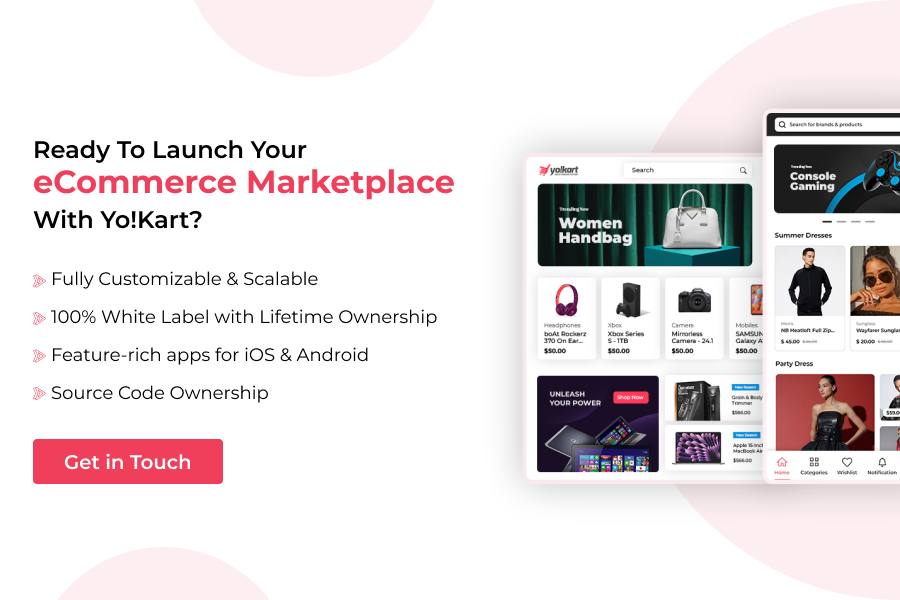Updated Date 17th Dec, 2025
The rise of digital commerce continues to reshape how goods are bought and sold globally. In 2026, online marketplaces are more dominant than ever, empowering entrepreneurs and businesses to connect with customers without the limitations of traditional retail.
However, one critical factor that determines the success of any marketplace is its revenue model; how the platform generates income while remaining competitive and valuable to vendors and buyers.
In this blog post, we will explore the top marketplace revenue models to boost growth in 2026, share key considerations for launching a platform, and explain how Yo!Kart helps you build and scale quickly.
Table of Contents
Different eCommerce Marketplace Revenue Models to Boost Growth
Marketplace revenue models have now evolved to better meet the needs of the customers. Rather than implementing a single revenue model, successful platforms now adopt multiple flexible and scalable revenue generation strategies. Marketplaces must strike a balance between profitability and seller retention, all while delivering value and transparency. Whether you’re targeting a niche platform or building a large multi-vendor ecosystem, the right revenue model plays a crucial role in long-term sustainability and growth.
Here are the top marketplace revenue models that can be the best fit to boost the growth of a platform:
1. Commission-Based Model
The commission-based model is one of the most popular and proven methods for marketplace monetization. Under this model, the marketplace owner takes a percentage, usually 15% – 30%, of each sale made by the sellers, effectively earning revenue from each transaction that occurs on the platform. This model creates a direct correlation between the marketplace’s revenue and the success of its sellers, fostering a mutually beneficial relationship.
Example: Prominent platforms like Amazon, Etsy, and eBay operate primarily using this revenue model.
How it works: For instance, if a vendor sells an item for $200 and the marketplace charges a 10% commission, the platform earns $20 from that sale. However, the commission percentage may vary depending on factors like product category, vendor agreements, and platform policies.
Pros:
- Scales easily with increased transaction volume
- Aligns marketplace success with vendor performance
- No upfront cost for sellers, reducing barriers to entry
- Provides a flexible revenue model based on sales volume
Cons:
- High commission fees can deter vendors, limiting platform growth
- Vendors may leave the platform if fees are perceived as too high
2. Listing Fee Model
The listing fee model requires sellers to pay a fixed fee to list each item upon reaching a certain freemium threshold, regardless of whether they make a sale. This model is typically used by platforms with large inventories or niche markets, where each listing can generate value through visibility, even without a direct sale. This ensures that only reliable sellers join the platform, as the upfront listing cost helps filter out less committed or casual sellers. This reduces the risk of low-quality or irrelevant listings cluttering the marketplace.
Example: Websites like Craigslist or Etsy use this model for certain categories, where sellers pay a flat fee to list an advertisement.
How it works: In this model, the sellers pay a flat fee to display the products on the platform, which is collected upfront. The listing fee typically stays the same regardless of the type and price of the product. For example, a seller might pay $10 to list a pair of shoes, while the other seller pays the same amount of money to list a bicycle, even though the products have different values.
Pros:
- Generates immediate, predictable revenue for the marketplace
- Encourages sellers to present only intentional, high-quality listings
- Works well for platforms with high listing volume or niche offerings
- Simplifies monetization structure without requiring complex calculations
Cons:
- May discourage small vendors due to the upfront listing cost
- May require significant traffic to justify the listing fees to sellers
Get a Future-Ready Marketplace Software with Flexible Revenue Models
3. Subscription Plans for Sellers
Sellers pay a recurring fee, either monthly or yearly, to access the platform in a subscription-based model. This fee can unlock various exclusive benefits for sellers, such as the ability to list more products, access premium features, reduced commission, or gain additional visibility on the platform. This model is commonly used in eCommerce platforms, including B2C and B2B platforms, allowing sellers to scale their businesses with a clear and predictable cost structure.
Example: Amazon Seller Plans, B2B ecommerce portals
How it works: A seller chooses from multiple pricing tiers based on features and listing limits. For example, a basic plan might allow a vendor to list a limited number of products, while a higher-tier plan offers benefits like unlimited listings, enhanced analytics, reduced commission rates, and premium visibility.
Pros:
- Generates predictable and stable revenue for the platform
- Filters out low-effort sellers, ensuring a more committed seller base
- Scalable monetization model that accommodates growing marketplaces
- Provides vendors with access to premium tools that can boost sales
Cons:
- May discourage new or small sellers due to upfront costs
- Requires a clear value for the subscription to justify the fees
4. Freemium + Paid Upgrades
This model combines free access to basic platform features while monetizing advanced capabilities through paid upgrades. It is a popular strategy designed to attract a wide range of sellers by removing the barrier to entry and providing them with an opportunity to start selling on the platform without any financial risk. Once sellers experience the benefits of the marketplace and start scaling, they can opt to pay for additional tools and features that help them scale their businesses more effectively.
Example: Many online marketplaces, such as Etsy and Poshmark.
How it works: Sellers get a limited but functional version of the platform, where they can list a limited number of products and access basic analytics. However, to scale, they need to upgrade to a premium plan to access the added benefits such as unlimited product uploads, advanced sales reports, and automated marketing tools.
Pros:
- Attracts a high volume of new sellers quickly without financial barriers
- Scales effectively as vendors grow on the platform
- Builds trust by allowing sellers to test before paying for premium features
- Generates recurring revenue through tiered subscriptions or upgrades
Cons:
- Requires compelling premium features to justify the upgrade
- Risk of competitors offering better free packages
5. Featured Listings
Empower sellers to boost their visibility on the platform through promoted listings, banner ads, or featured product placements. Sellers can gain priority placements across search results, category pages, and even homepage banners by investing in advertising, allowing them to stand out in highly competitive environments.
Example: Amazon Sponsored Listings, Etsy Ads, eBay Promoted Listings
How it works: Sellers can set a daily or monthly advertising budget and choose the products they want to promote. The platform promotes these products in premium spots across the website in exchange for a fee. In some cases, sellers may be charged on a cost-per-click (CPC) basis, while others may operate on a cost-per-impression (CPM) model.
Pros:
- Generates high-margin revenue with minimal overhead
- Helps enhance seller visibility in crowded marketplaces
- Provides measurable results with clear performance metrics
- Encourages sellers to reinvest due to strong ROI potential
Cons:
- Effectiveness depends heavily on consistent user traffic
- Overuse may affect user experience
6. Third-Party Ads and Partnerships
This model allows the marketplace owner to generate revenue by displaying advertisements from third-party businesses or by collaborating with brands for sponsorships and promotional campaigns. This can take the form of banner ads, promoted placements, or exclusive brand partnerships. Instead of relying solely on transaction-based income, this model monetizes the platform’s user base and traffic by offering advertising space or co-branded opportunities.
Example: Platforms like Craigslist, Facebook Marketplace, and Yelp often display Google Ads or run brand partnerships to diversify revenue streams.
How it works: A marketplace may charge third-party businesses a fixed fee or use a cost-per-click (CPC) or cost-per-impression (CPM) model to display their ads on high-traffic pages such as the homepage or category section. Additionally, strategic partnerships may include co-marketing campaigns, featured listings, or sponsored content, earning revenue through referral fees, lead generation, or shared profits.
Pros:
- Diversify revenue streams beyond just transaction fees
- Enhance marketplace visibility with co-branded campaigns
- Partnerships enhance brand credibility and user trust
- Generated revenue even if transaction volume is low
Cons:
- Ads may disrupt the user experience if poorly targeted
- Requires significant traffic volumes to attract valuable advertisers
7. Hybrid Revenue Models
Hybrid revenue models combine multiple monetization strategies within a single marketplace, creating a diversified and resilient income stream. This approach allows the marketplace owner to serve different types of sellers and adapt to varying business needs, allowing platforms to remain flexible, reduce dependence on a single revenue stream, and adapt to changing market demands.
Example: Amazon operates under a hybrid model that includes commissions on sales, advertising fees for sponsored listings, and subscription fees for services like Amazon Prime or professional seller accounts.
How it works: A marketplace might charge sellers a monthly subscription fee to access premium features, apply a commission on every sale, and offer advertising options for sellers who want additional visibility. For instance, a seller could pay $40/month for a professional account, give 15% commission per sale, and also purchase sponsored ads to boost product placement.
Pros:
- Diversified revenue streams reduce dependency on a single model
- Caters to different seller profiles, from small businesses to large enterprises
- Increases revenue potential by layering multiple income streams
- Supports long-term scalability and platform sustainability
Cons:
- Slightly more complex to manage operationally and technically
- Risk of overwhelming vendors with too many fees or unclear pricing structures
Launch a Powerful Marketplace That Maximizes Revenue Potential with a Hybrid Revenue Stream
| Revenue Model | How It Works | Revenue Potential | Best Suited For |
| Commission-based | Charges a percentage on each sale made through the marketplace | Scales directly with transaction volume | General B2C/B2B marketplaces |
| Listing Fee | Sellers pay a fee to list items, regardless of sales | Provides guaranteed upfront income | Niche or curated marketplaces |
| Subscription Plans | Sellers pay a recurring fee for access or added features | Predictable and Recurring Revenue | High-volume vendors or tiered marketplaces |
| Freemium + Upgrades | Basic access is free; sellers pay for premium tools, limits, or visibility | Scales as vendors grow and upgrade to premium features | Emerging or growth-stage marketplaces |
| Featured Listings | Vendors pay to promote listings or gain better visibility | High margin, dependent on traffic & competition | Mature marketplaces with an active user base |
| Third-party Ads & Partnerships | External brands or partners pay for ad placements, sponsorships, or cross-promotions | Additional revenue without relying on sellers | Marketplaces with significant traffic/audience |
| Hybrid Models | A combination of multiple revenue models to suit different vendor segments | Diversified and resilient revenue streams | Scaling or enterprise marketplaces |
Trends Shaping Marketplace Monetization in 2026
As marketplaces mature, monetization strategies are evolving beyond traditional models. Emerging technologies and shifting vendor expectations are driving smarter, more flexible, and service-oriented revenue approaches. Here’s a look at a few trends shaping marketplace monetization in 2026:
- AI-Powered Pricing Models: Marketplaces are increasingly leveraging Artificial Intelligence to set dynamic commission rates, advertising costs, and promotional fees. Pricing is adjusted in real time based on factors like product demand, seasonality, seller performance, and competitive benchmarks, ensuring maximum revenue without alienating vendors.
- Dynamic Seller Tiers: Instead of one-size-fits-all pricing, sellers are segmented into performance-based tiers. High-performing vendors gain access to premium tools, visibility, and more, while emerging sellers can start with entry-level plans. This flexible model drives vendor loyalty, incentivizes growth, and aligns marketplace revenue with seller success.
- Integrated Financial Services: Marketplaces are evolving into financial platforms by integrating digital wallets, instant payouts, Buy Now Pay Later (BNPL), and micro-lending options. These services not only create additional revenue streams but also strengthen vendor retention by embedding financial infrastructure directly into the marketplace ecosystem.
Building a Marketplace in 2026: Strategic Steps to Consider
Launching a marketplace today goes beyond simply connecting buyers and sellers; it requires careful planning, the right technology, and a strong growth strategy. Below are the key steps to ensure long-term success:
1. Identify a Clear Niche: Begin by targeting a well-defined segment with proven demand, whether that’s fashion, electronics, organic goods, or collectibles. A focused niche can drive early traction and help build a loyal community before scaling out to a broader audience.
2. Select the Right Revenue Strategy: Choose monetization strategies aligned with your niche and vendor base. Whether commission-based, subscription-driven, or hybrid, ensure the model strikes a balance between profitability and vendor incentives to keep sellers engaged.
3. Invest in a Scalable Technology Partner: Instead of reinventing the wheel and building a platform from scratch through custom development, leverage robust multi-vendor marketplace software that offers flexibility, customizability, and scalability. This approach accelerates the market launch, reduces technical overhead, and keeps you future-ready for the increasingly competitive landscape, allowing you to swiftly expand to international markets.
4. Prioritize User Experience: Deliver a seamless experience with intuitive navigation, fast search, mobile optimization, and secure transactions. The easier it is for buyers and sellers to interact, the stronger it is to retain users and maximize conversion rates.
5. Strengthen visibility with SEO & Marketing Tools: Build marketing into the foundation, integrate SEO, analytics, automation, and product tagging from day one. A marketplace that is easily discoverable and measurable ensures steady traffic and sustainable growth.
Best Multi-vendor Marketplace Software to Launch a Marketplace
In today’s fast-paced digital economy, time-to-market can be the defining factor between success and missed opportunity. Yo!Kart is a purpose-built, self-hosted multi-vendor marketplace software that enables entrepreneurs and enterprises to build and launch online marketplaces quickly without compromising on quality, performance, or scalability.
Whether you’re targeting niche segments or looking to create the next big horizontal marketplace, Yo!Kart streamlines the journey from concept to launch. Here’s how it accelerates marketplace development:
- Pre-Built Multi-Vendor Architecture:
Yo!Kart comes with a fully integrated multi-vendor infrastructure that supports multiple seller accounts, independent dashboards, product management, order tracking, and payout handling right out of the box. This drastically reduces the time and effort needed for custom development.
- No Need to Start From Scratch:
Unlike open-source platforms or SaaS tools that require extensive add-ons or custom coding, Yo!Kart is designed with marketplace-specific features already in place. This eliminates delays caused by third-party integrations or feature development.
- Quick Setup & Easy Customization:
Yo!Kart offers a user-friendly admin panel, robust CMS, and modular codebase that makes customization seamless. Whether you need to change the design, integrate new payment gateways, or implement a specific business logic, Yo!Kart’s framework is developer-friendly and highly extensible.
- All Essential Features Included:
The platform is equipped with all the essential tools required to operate a full-fledged marketplace, including robust product catalog management, shipping and tax modules, mobile-optimized responsive design, multiple payment gateways, advanced reports & analytics, and GDPR compliance & data privacy features. This means less reliance on plugins or custom coding and more focus on business growth.
- Faster Time-to-Market:
With its out-of-the-box functionality and dedicated onboarding support, Yo!Kart significantly reduces development timelines. Depending on your level of customization, a marketplace can go live within a few days or weeks, giving you a head start over competitors.
- Backed by Expert Support:
Yo!Kart is backed by a team of eCommerce experts and offers dedicated technical assistance post-launch. Whether you’re just starting out or planning long-term platform expansion, Yo!Kart provides the stability and expertise needed to grow your marketplace with confidence.
- Trusted by Businesses Worldwide:
With successful implementations across industries and geographies, Yo!Kart is trusted by startups, SMEs, and enterprises around the globe. Its proven track record reinforces its reliability as a go-to solution for building scalable online marketplaces.
- Perfect for All Marketplace Types:
Yo!Kart is flexible enough to support various business models, including B2B, B2C, P2P, and more. From fashion to electronics to industrial equipment, it can be tailored to your niche with ease.
Schedule a Personalized Demo to Know More About Yo!Kart
Final Thoughts
The marketplace landscape in 2026 offers tremendous opportunities but also fierce competition. Success depends on choosing the right revenue model, delivering great user experiences, and leveraging technology that scales. Equally critical is speed; launching fast gives you a competitive edge. With a reliable, feature-rich multi-vendor solution like Yo!Kart, you can go to market quickly, attract users early, and start generating revenue without delay.
Hence, by combining the right tools with smart strategies, you can build a marketplace that not only thrives today but remains future-ready as well.
FAQs
Q 1. What is the best revenue model for marketplaces in 2026?
Ans. The commission-based model remains the most popular due to its scalability. However, many platforms adopt hybrid models (e.g., commissions + ads or subscriptions) for long-term profitability.
Q 2. Can I use multiple revenue models at the same time?
Ans. Yes. Most successful marketplaces use a hybrid model, combining listing fees, commissions, subscriptions, price surge, and sponsored promotions.
Q 3. How fast can I launch a marketplace with Yo!Kart?
Ans. With Yo!Kart, you can launch a fully functional platform in just a few days, depending on the level of customization. Contact our sales team for more detailed information.
Q 4. Do I need technical knowledge to run a marketplace built with Yo!Kart?
Ans. Not necessarily. Yo!Kart includes a user-friendly, intuitive admin panel, so you can manage operations easily without any prior technical expertise.
Q 5. Is Yo!Kart optimized for SEO and mobile?
Ans. Yes. Yo!Kart follows SEO best practices, ensuring better visibility on search engines. It’s fully responsive across devices and comes with native mobile apps, delivering a seamless shopping experience for buyers on the go.
Q 6. Is Yo!Kart suitable for both startups and enterprises?
Ans. Absolutely, Yo!Kart supports businesses of all sizes, whether startups, SMBs, or large enterprises. Whether you’re launching your first marketplace or scaling an existing one, Yo!Kart is flexible enough to support your journey at any stage.




